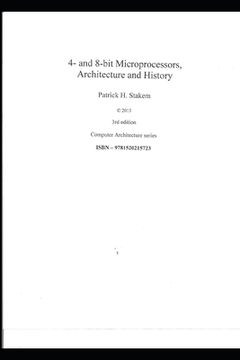4- and 8-bit Microprocessors, Architecture and History.
Synopsis "4- and 8-bit Microprocessors, Architecture and History."
This book surveys the history and architecture of 8-bit microprocessors. We actually start with 4-bit microprocessors, look at a strange 1-bit processor, and look at 8-bit, then 12 bit micros. The 16-bit processors will be the subject of another book. Eight bit processors are still manufactured and used. This book is not an exhaustive view of the field, but the major players are covered. There is a review of computer architecture, binary math, and digital logic that can be skipped. The evolution of the 8-bit processors is a history of the advance of semiconductor technology from the first transistors, to the breakthrough of multiple transistors on a chip, the integrated circuit. A lot of this happened when the "Silicon Valley" of northern California was mostly known for its citrus crops. The tools that made all this happen were large mainframe computers with vacuum tube technology, punched card input, and memory drums with the staggering capacity of a thousand words. The growth of the integrated circuit shows what Gordon Moore observed was an exponential growth law: the complexity increased about every 18 months. Naturally, this growth rate is not sustainable forever. But, in the age of multi-core 64 bit microprocessor systems on a chip, so far, so good.Modern computers started out using relays and vacuum tubes, switching to mechanical relays for switching elements. The semiconductor revolution provided diodes for logic functions, and transistors for switching. As the technology allowed for putting multiple transistors and other elements on a single substrate, the integrated circuit began to be widely used. The complexity of the devices increased according to an exponential growth law, the technology feeding upon itself. This allowed for functions such as an arithmetic-logic unit to occupy one chip. Then, at around 4,000 transistors capacity, an entire 4-bit cpu that executed instructions. Not much later came the 8-bit cpu. Memory and I/O functions also benefited from the increasingly complex solid state-electronics.glossary, bibliography, and pictures are included.The author built an Intel 8080-based Altair 8800 computer in 1975. He went to the Big Computer Faire in Atlantic City, and saw two guys, both named Steve, from California, with a wooden-cased project that probably wasn't going to go anywhere commercially. His Aerospace career has revolved around support for space-based microprocessors and computers for NASA since 1971.Mr. Stakem received a Bachelor's Degree in Electrical Engineering from Carnegie Mellon University, and masters in Physics and Computer Science from the Johns Hopkins University. He has followed a career as a NASA support contractor, working at every NASA Site. He is associated with the Graduate Computer Science Department at Loyola University in Maryland, and the Whiting School of Engineering of the Johns Hopkins UniversityAnother book by the author discusses 16-bit microporcessors.

